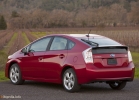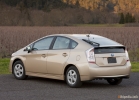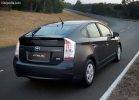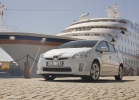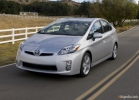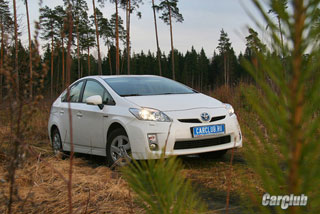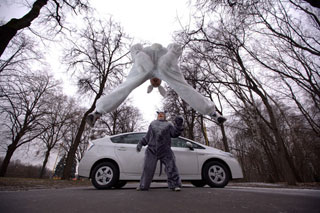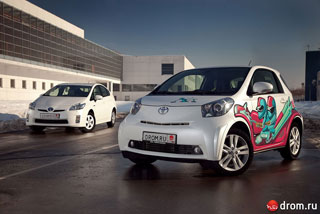Toyota Prius test drive since 2009 hatchback
Another
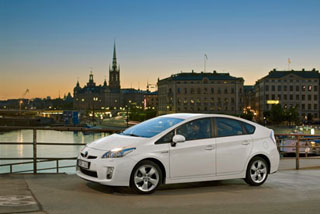 As a result of the survey, it turned out that the Russians were not able to attribute the Toyota Prius hybrid to any particular segment of cars. So he will have to occupy a niche in our minds
As a result of the survey, it turned out that the Russians were not able to attribute the Toyota Prius hybrid to any particular segment of cars. So he will have to occupy a niche in our minds It is difficult to call any other car in the average price range that would not dare to sell in Russia for so long. Judge for yourself: in Japan, the hybrid Prius appeared in the last century - in 1997 at the junction of the century, the model came to the USA (2000) and Europe (2001). And only now the Toyotovites got the courage to introduce it to us. And without confidence in explosive sales. But - with the calculation to stake a bridgehead from which they will later be able to close growing demand. And the Japanese will not doubt the fact that such will appear on the Russian market. In order to evaluate this confidence, you should understand two things: what is the essence of the Hybrids machine and how their world market looks like.
If we talk about the first question briefly, then the main thing in hybrids is their efficiency and environmental friendliness. They consume extremely little gasoline, and therefore less other cars pollute nature and more than the rest cherish the money of the owners. This is achieved due to the fact that in pairs with an internal combustion engine, an electric motor is working. It helps to accelerate the machine and increases its power, in addition, there is no idle speed on the hybrid. So, the load on the gasoline unit is reduced.
As for the second aspect, Toyota is definitely a world leader in the field of hybrid technologies. She was the first in the world to bring a mass hybrid model to the market - the first Prius. Then she introduced the same technologies in the premium segment, transferring them to Lexus cars. As for Prius II, he conquered almost all the titles of the car idond: more than once his power plant was recognized as the engine of the year and the most economical engine, and the car itself was called the best car in 2004 in North America and 2005 in Europe.
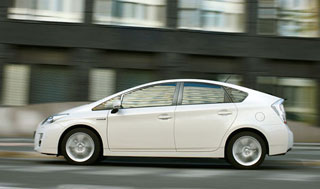 As a result of the Prius alone (the first, intermediate and second generations), more than 1.2 million units have already been sold in the world, and, for example, more than 30 hybrid models from different manufacturers are being implemented in America. But the Toyotovites are sure that Prius III will strike another competitors. We went to the test of this car to Sweden to evaluate how justified the ambitions of the Japanese are.
As a result of the Prius alone (the first, intermediate and second generations), more than 1.2 million units have already been sold in the world, and, for example, more than 30 hybrid models from different manufacturers are being implemented in America. But the Toyotovites are sure that Prius III will strike another competitors. We went to the test of this car to Sweden to evaluate how justified the ambitions of the Japanese are. Closer to people
Sweden was not accidentally chosen for the European presentation of the new Prius. It is known how obsessed its citizens are security, including environmental. Confirmation of this is a lot of hybrids in the country. I even had the impression that half of the Stockholm taxi park is precisely Prius. And in private use there are a lot of them. So next to our new machine, samples of the second generation arose every now and then, and it was easier for us to compare their appearance.
The conclusions are: if you look from a distance (from the side or from behind), then you will not distinguish Prius II from Prius II from Prius II - the same hunchbacked silhouette, similar body contours. But after a couple of moments you understand where the new product is, and where is its predecessor. The third Prius is much more like modern cars: it has a completely organic appearance, you feel some kind of tightness and even elegance. Here the work of designers played a role. For body panels, they used new stamps, and the highest point of the roof was shifted 100 mm ago. This allowed the rear passengers an additional 15 mm above their heads and get a more balanced visually body.
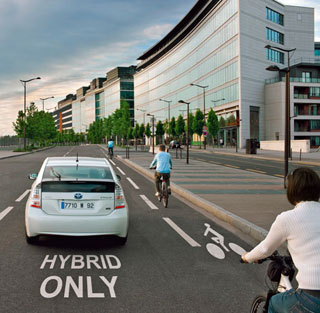 It was impossible to do more - aerodynamics would suffer. The fact is that the same egg -shaped silhouette that many do not like so is the key to the technical and consumer characteristics of the machine: it is it that allows you to achieve maximum fuel savings. The factor of the frontal resistance on Prius was previously fantastically low - only 0.26, but now, in the new generation, the Japanese managed to bring it to 0.25, and this indicator was not able to boast of any of the competitors (despite the fact that the length and width of the car increased by 15 and 20 mm, respectively). A new optics also gives the hatchback: the front and rear lights have radically changed, the fog of the air intake migrated into the corners of the bumper.
It was impossible to do more - aerodynamics would suffer. The fact is that the same egg -shaped silhouette that many do not like so is the key to the technical and consumer characteristics of the machine: it is it that allows you to achieve maximum fuel savings. The factor of the frontal resistance on Prius was previously fantastically low - only 0.26, but now, in the new generation, the Japanese managed to bring it to 0.25, and this indicator was not able to boast of any of the competitors (despite the fact that the length and width of the car increased by 15 and 20 mm, respectively). A new optics also gives the hatchback: the front and rear lights have radically changed, the fog of the air intake migrated into the corners of the bumper. I compare the design of the new machine and its predecessors only because the appearance of the second Prius for many Russians was controversial, and this has become one of the factors of the model’s rejection. As for other indicators, I will try to avoid comparisons for two reasons: firstly, the model in Russia has not yet been officially sold, and the gray cars park are extremely small; Secondly, Prius III in itself is so innovative that you simply don’t have enough space to tell about all its technical lotions.
We speak Russian
To begin with, briefly about the interior and the cabin as a whole. The first thing you notice is the excellent quality of materials and assemblies: they did not save on plastic or fabrics here. Everything looks good and pleasant to the touch. The soft color scheme relaxes, only the blue handle of the movement selector stands out, but this is done consciously - it reminds of the hybrid essence of the car. Instead of a familiar combination of devices behind the steering wheel rim - an elongated display in the middle of the front panel. He gives out all important information: speed, current time, consumption and fuel volume in a 45-liter tank, the degree of battery charge from which the electric motor works; At the same time, the process of its charging during movement also demonstrates. However, such a display does not mean that the driver must constantly mow an eye. On the contrary, the most necessary information is always right in front of it: speed is projected onto the windshield, and before turning or a denouement - the distance to the object and the direction of movement. Until now, this has been proposed only on expensive models of the premium segment.
The steering wheel is somewhat unusual in shape: you can’t even call it the wheel, since the lower part is slightly braked. On the trunk itself there are buttons of the audio system, turning on adaptive cruise control, and climate control systems. The remaining controls are concentrated in the lower part of the front panel and around the color multimedia display (by the way, the Russian language is already programmed in it, including for voice navigation). Almost everything is combined successfully and logical. Almost, because the heating button caused a dispute. She is in the niche under the panel on which the selector is located, and in order to press it, you need to bend slightly. In my opinion, this is a trifle, especially since Prius offers unexpectedly high comfort where you do not wait for it.
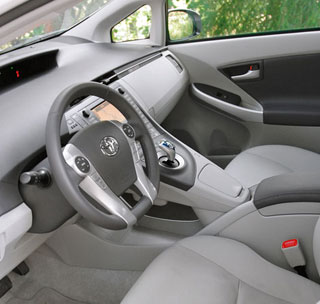 For example, the chairs turned out to be incredibly convenient, despite the fact that the adjustments are at least: the back tilt, two directions for the seat pillow (up-down and back and forth) and the drive of the lumbar backup. I don’t know how the Japanese succeeded, but there is no more here: the driver of any complexion in these chairs feels as if they had been made for him. The back row is good: two adults and a child can go there, while there are many legs for legs, the back and neck do not get tired in the long road, and even on the winding highway does not rock the highway. Add excellent acoustics to this - and when the radio is turned on, the fellow travele sitting behind is well heard.
For example, the chairs turned out to be incredibly convenient, despite the fact that the adjustments are at least: the back tilt, two directions for the seat pillow (up-down and back and forth) and the drive of the lumbar backup. I don’t know how the Japanese succeeded, but there is no more here: the driver of any complexion in these chairs feels as if they had been made for him. The back row is good: two adults and a child can go there, while there are many legs for legs, the back and neck do not get tired in the long road, and even on the winding highway does not rock the highway. Add excellent acoustics to this - and when the radio is turned on, the fellow travele sitting behind is well heard. The cabin has many compartments, boxes, pockets. In the doorway - places for bottles, in the folding back of the rear sofa - cup holders. The seats themselves in the second row can be folded in a proportion of 1/3 or 2/3. Either the whole, and then in the trunk, the volume of which increases from 445 liters to 1120 liters, even a bicycle will fit. In the standard position, the cargo compartment seems small, but under its flooring there is a roomy tray, below which there remains a place for the spare. In general, Prius is convenient for long -distance travel and everyday movement around the metropolis.
More than it seems
Unlike all competitors, Prius III is a full -hybrid model. This means that the car can use one electric motor and a separately gasoline engine, as well as their combination. True, you won’t pass a lot and quickly on the battery - the charge is enough for about 2 km, and at a speed of more than 50 km/h, the internal combustion engine turns on (the battery, meanwhile, is recharged). But in traffic - zero gasoline consumption. The Power Mode mode, which increases the drive power, allows you to make an aggressive riding: pressing this button immediately spurns the car, and I scored 160 km/h on the Swedish autobahn almost playfully (I no longer risked - they don’t ride so quickly, and the police are not joking). In general, a combination of a 1.8-liter gasoline four with a capacity of 98 hp. And the 38-horsepower electric motor allows the Prius III to summarize 136 horses (there were 110 in Prius II), dial a maximum speed of 180 km/h, and accelerate to 10.4 s to hundreds.
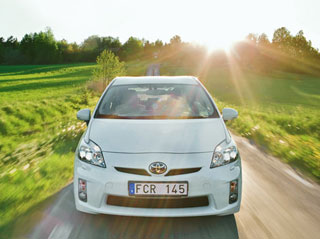 Similar parameters are characteristic of ordinary D-class machines with 2 liter engines. But can such cars spend as little gasoline as Prius? We conducted an experiment: in the most economical ECO mode, when all the elements of the company Toyota drive Hybrid Synergy Drive are included, a section of the combined route drove: there were slopes, straight, and intersections. The average gasoline consumption was 3.4 liters per 100 km. A colleague who travels to the second Prius in Moscow showed 2.1 liters - even the organizers of the test drive applauded him. In general, Toyota declares the average fuel consumption at 3.9 liters per 100 km. I, taking into account traffic jams in Stockholm and a very fast highway ride, spent less than 4.5 liters at the same distance. Awesome economy!
Similar parameters are characteristic of ordinary D-class machines with 2 liter engines. But can such cars spend as little gasoline as Prius? We conducted an experiment: in the most economical ECO mode, when all the elements of the company Toyota drive Hybrid Synergy Drive are included, a section of the combined route drove: there were slopes, straight, and intersections. The average gasoline consumption was 3.4 liters per 100 km. A colleague who travels to the second Prius in Moscow showed 2.1 liters - even the organizers of the test drive applauded him. In general, Toyota declares the average fuel consumption at 3.9 liters per 100 km. I, taking into account traffic jams in Stockholm and a very fast highway ride, spent less than 4.5 liters at the same distance. Awesome economy! Finally, the Third Prius has another function on which the Toyota will bet in Russia. This is automatic parking. When you slowly move along the standing cars, the system, if you activate it with a button, selects a suitable place itself and offers the driver to park. Then you need to release the steering wheel and only adjust the speed: the electronics itself will unscrew the steering wheel by pointing the car along the optimal trajectory. So you can carry out both side parking and the back. I myself tried this maneuver, and I can assure: it works.
I will also inform potential buyers that Prius III will appear in Russia at the end of the year and will be offered in five colors and two trim levels. In the database-the entire set of safety systems (including seven pillows and active head restraints), 15-inch alloy wheels, heated mirrors, climate control, multifunctional steering wheel, car access systems and its key in the more expensive version are rain sensors And light, leather salon, Russified navigation, LED headlights and several more pleasant options. There is only only one - price tags. They will be unleashed in the fall.
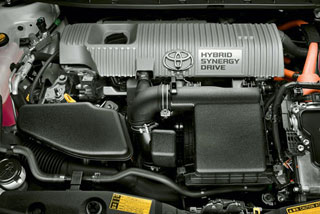 It is assumed that by that time the Russians will be able to determine for themselves what Prius is. Now opinions have been divided between categories such as a small business class, almost a business class and an economical golf class. Apparently, in each version (given its size between C- and D-class) there is its own proportion of truth, although Prius will still stand in our market a mansion. Like it or not, he is not like everyone else. He is different.
It is assumed that by that time the Russians will be able to determine for themselves what Prius is. Now opinions have been divided between categories such as a small business class, almost a business class and an economical golf class. Apparently, in each version (given its size between C- and D-class) there is its own proportion of truth, although Prius will still stand in our market a mansion. Like it or not, he is not like everyone else. He is different. Technical characteristics of Toyota Prius III
Dimensions, mm 4460x1745x1490
Base, mm 2700
Equipped mass, kg 1445
Trunk volume, l 445-1120
Benzine engine L4 + electric motor
Working volume, cubic meter. cm 1798
Max. Power, L.S./rpm 98/5200
Max. moment, nm/rpm 142/4000
Total max. Power, L.S. 136
Incavigated transmission with electronic control
Front drive
Max. Speed, km/h 180
Acceleration time 0-100 km, from 10.4
Fuel consumption (average), l/100 km 3.9
Tank volume, l 45
Andrey Bezverkhov
Photo by the author and the manufacturer
Source: Avtopanorama magazine

